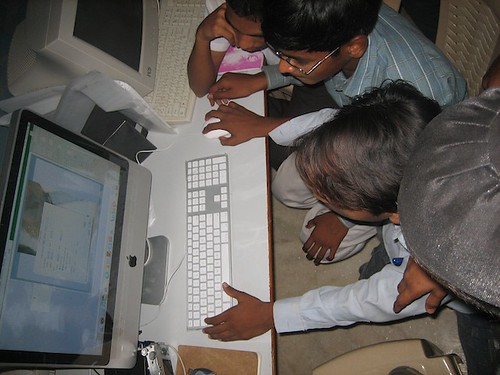Tuesday, February 26
After two intense days of computer focused lesson plans, the boys in Nalgonda are off and running with the Final Cut video-editing software they’re using for their “A day in the life of” projects. Most of our classes begin the same way: Our 12 push through the dense ring of boys that has circled us in the computer classroom. Numerous PC’s are turned on, and traditional and disco-esque house music plays through the speakers of a couple computers. Everyone, including our 12, huddle around the computers, clicking, making elaborate posters with their names in artistic fonts using powerpoint, and playing around with the half-dozen songs they have uploaded to the computer and can now access through Windows Media Player. This all happens in the first 5 to 15 minutes before class starts. The boys pass off control of the mouse like passing a bag of M&M’s, everyone gets a few clicks, completes a few tasks, and then the mouse is passed… or grabbed. Personal space around the computer is not the issue; they are all just trying to get a peak at the screen, at the programs, at the technology.
The rush in and absorb as much of the computer as they can before being kicked out so our class can start. At the end of our class, around 4:30pm, the same scenario plays out if there is not a high-profile cricket match to watch in the courtyard. But, still, even then there is a throng of boys rushing in to switch on the computers and watch what our class has created during the time they’ve been IN THE COMPUTER CLASSROOM! I mean, really, the place is like a posh club scene with lines out of the room; several bouncers guard the door and regularly toss unruly individuals out, while the “cool few” march in and get access to the computers that are quickly turned on. The boys come to observe, ask questions about “everything technology” that they see in the classroom and in our bags, and practice their English.

A week ago, I had a discussion about computer memory with a group of class 10 boys who always eagerly approach me when our class is finished. They saw Piya hand me her pocket flash drive (aka “stick” flash memory drive – USB) and asked what it was. They told me that they were interested in computers and a couple wanted to be software/hardware engineers. I handed the flash drive to them and was floored at how attentive they were while I talked about nano technology and the future of flash memory drives in computers. The boys wanted to see more technology, to use it more often. They wanted to absorb more, to learn, to participate in the larger discussion that could just be about computers, or could be about global jobs, opportunities inside and outside of their country.
The computer room is open to students during their “computer class” period. Unfortunately, the oldest students in the school – class 10 – who are the most fluent in English and are consistently the first to greet us when we arrive, are not allowed to use the computers. Their computer education stops after class 9, as class 10 spends the entire year studying for their final Class 10 Exam, which, depending on the score a student earns, basically decides if and where the student has a chance applying to college… the opportunity to move forward in their education.
I started this post by saying that the boys in our class are off and running with the Final Cut software, and I mean it. As I half-expected, much of my instruction on the first day fell on deaf ears – the program engulfed their senses, and the group of six huddled around the computer looked at me like a smudge on the wall, I was there on the wall and that was about it. Toward the end of class, my voice was getting through, but, really, most of the learning was done through trial and error with this particular group. I watched as they found the different tools on the screens, differentiated between single and double-clicking for certain commands, and noted the various ways that video clips could be placed on the storyboard, cut, and overlapped. The boys were hands-on, using a tool and figuring out just how it acted and what it could do. The boys were editing.
The second day using the Final Cut software was quite inspiring. The boys got right down to the business of editing, remembering where and how to make the cuts, and listening to each other as they talked about everyone’s opinion of each clip. There was a genuine Socratic discussion happening around the computer – talking, deciding, and creating, together.
The group’s video of “A day in the life of” is now finished, and they will soon shift to their next and final project that will combine all of the photo, video, and writing exercises they have completed over the past 5 weeks. We’ll be posting a description/ outline soon…
In the short time before and after our class, the boys’ curiosity floods the computer classroom. Students rush in like a heavy set and wash over the computers and the room. Eagerness around learning the computer extends beyond the 12 in the class and into the minds of the boys who continuously make the most of their 5-15 minutes of “computer curiosity”…in the hot club…the computer classroom.





